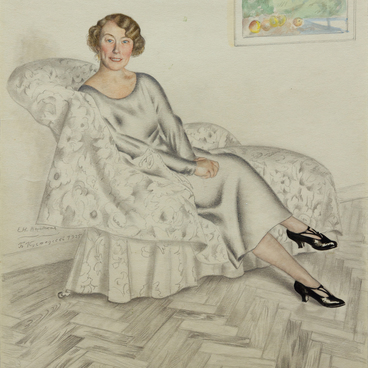Two-part icons with a keel-shaped top were common throughout the small North Russian churches. They were part of the iconostasis, placed in its upper tiers and usually consisted of the face of the saint and an image of a Gospel scene. The upper tier usually had images of Old Testament prophets.
Gideon the Prophet and the Nativity of Christ
Время создания
Late 17th - early 18th century
Размер
144x50,4 cm
144х50.4х2.9 cm
144х50.4х2.9 cm
Техника
Wood, tempera
0
Открыть в приложении#11
Unknown author
Gideon the Prophet and the Nativity of Christ
#2
#4
Gideon the Prophet
#12
Gideon the prophet lived in the 11th century BCE and was famous for his miracles — he made predictions and foretold natural disasters. He also was at the head of the Israelite army in the war against the Midianites, a nomadic tribe from Sinai. Nomads harried Jerusalem for seven years but fled after the battle with Gideon’s troops and stayed away from Israel for hundreds of years. Gideon the prophet was also named Jerubbaal, the fighter against Baal, because he demolished the altar to this thunderer god.
Icons of Gideon may differ showing him either as a young warrior or a venerable elder. In some icons he holds a jar but, more commonly, Gideon’s attributes include a scroll and a fleece. These items symbolize the scene of the miracle with the fleece. To make pagans believe in the one God, Gideon put a fleece on the ground and said that if he were right, the fleece would come to be covered with dew while the grass around remained dry. And when the dew appeared on the grass, the fleece would dry up. As the legend has it, it happened exactly so.
#6
Technique
#7
The icon of Gideon the Prophet and the Nativity of Christ was painted in the Vologda region between the end of the 17th and the beginning of the 18th century. Vologda masters used a novel icon technique in this work, namely, the underpainting (roskrysh), applied evenly as a first coat of paint, followed by other coats. The roskrysh on faces, hands and open parts of the body of saints was called sankir. Gideon’s face is modelled with the dark olive sankir, the fine white lines on the protruding parts of the face are done with white paint and the blush is applied with tempera. Tempera is a paint of powdered pigments dispersed in egg yolk.
#8
Icon of the Nativity of Christ
#9
The lower tier has the icon of the Nativity of Christ telling the story of the birth of Jesus Christ. It shows the cave with the baby Jesus in the crib, Joseph, the magi with their gifts, the star of the Bethlehem and the scene of bathing the infant Jesus. In icon-painting this scene is a canonical depiction of the feast of Christmas.
#10
The icon had been housed in Vologda churches until, in the second half of the 20th century, it ended up in the collection of Viktor Samsonov, a patron of arts. In 1996 the icon was acquired by the Generations Foundation of the Khanty-Mansy Autonomous District for its Rarities and Treasures of Art collection. Fifteen years later the icon of Gideon the Prophet and the Nativity of Christ was handed over to the museum.
#13
State Museum of Fine Arts of Khanty-Mansiysk
читать дальшескрыть
00:00
00:00
1x
Gideon the Prophet and the Nativity of Christ
Время создания
Late 17th - early 18th century
Размер
144x50,4 cm
144х50.4х2.9 cm
144х50.4х2.9 cm
Техника
Wood, tempera
0
Открыть в приложении
Поделиться


